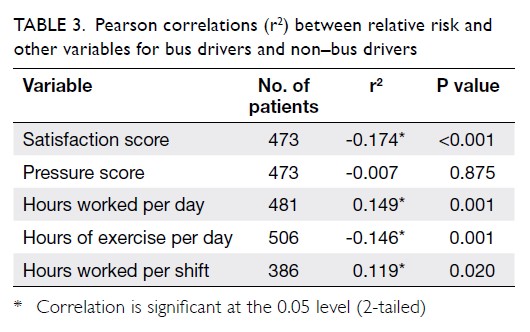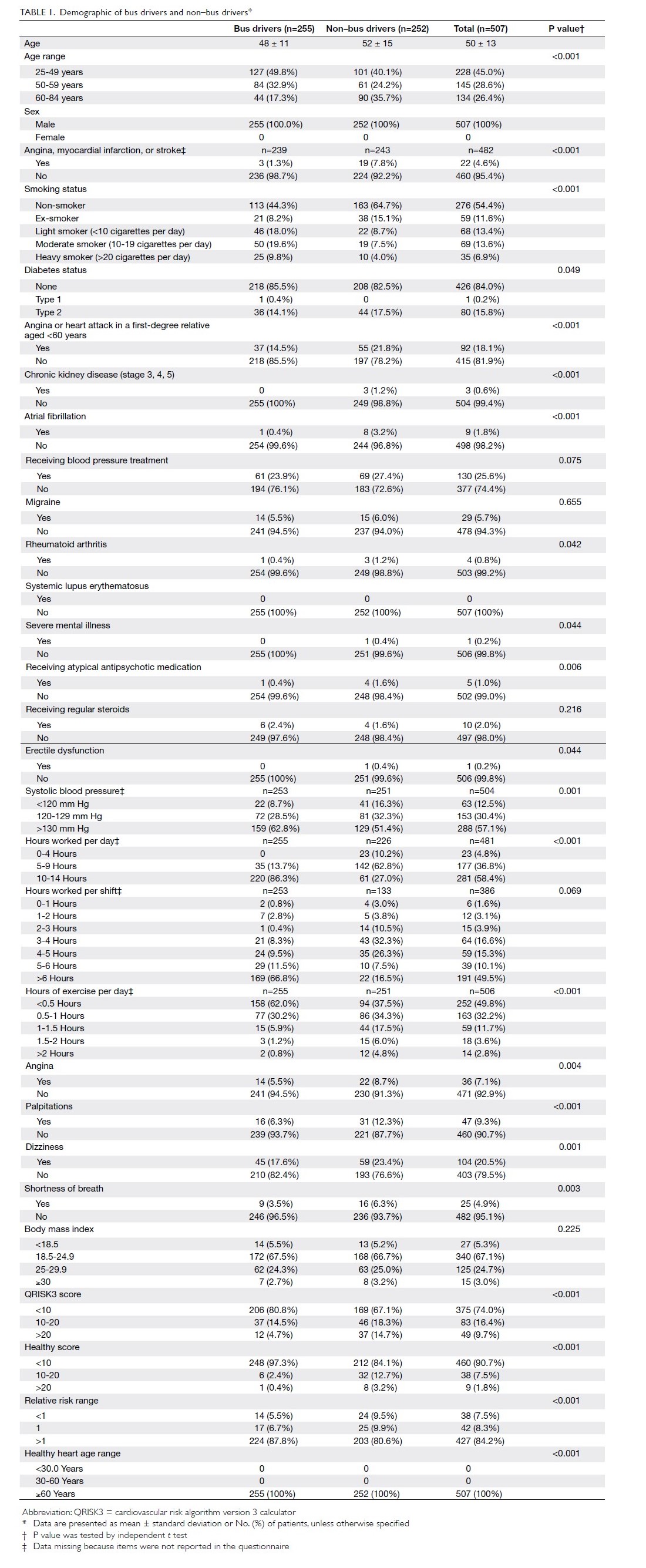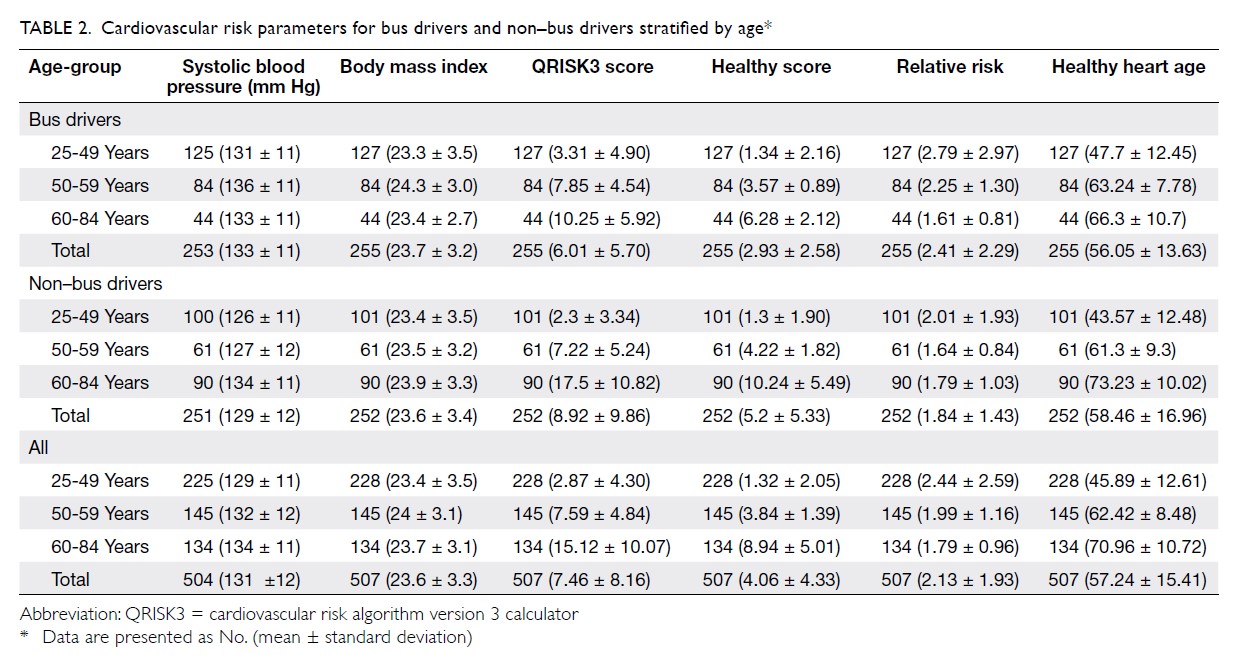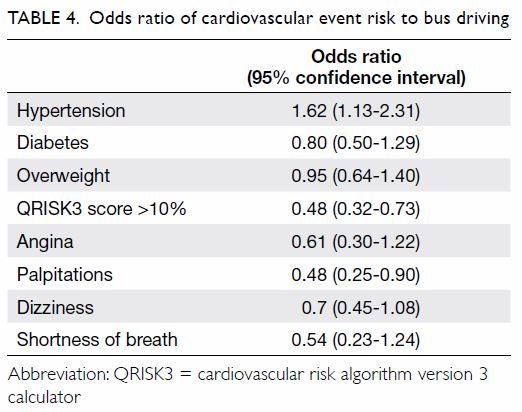Hong Kong Academy of Medicine. CC BY-NC-ND 4.0
COMMENTARY
Cardiovascular risk in bus drivers
Chloe KY Cheung1, Sunny SL Tsang1, Oliver Ho1, Nathan Lam1, Edmund CL Lam1, Carolyn Ng1, Frances Sun1, Brian Yu1, Natalie Kwan1, Gilberto KK Leung1,2, MB, BS, PhD
1 Li Ka Shing Faculty of Medicine, The University of Hong Kong, Hong Kong
2 Department of Surgery, Li Ka Shing Faculty of Medicine, The University of Hong Kong, Hong Kong
Corresponding author: Prof Gilberto KK Leung (gilberto@hku.hk)
Introduction
Driver health is an important issue worldwide.
Cardiovascular risk is well known to be higher in bus
drivers than in the general population.1 2 3 4 5 Although
much media attention has been drawn towards the
recent increase in bus accidents in Hong Kong,6 7 8 few
studies or measures have been carried out. The aim
of this study was to examine available findings on
cardiovascular risks among bus drivers and related
policies on risk modification internationally and in
Hong Kong.
Cardiovascular risk in bus drivers
Previous studies have documented cardiovascular
risk in professional drivers. In Korea, a cross-sectional
study on 443 male bus drivers compared
their incidence of hypertension (53.3%) with two
control groups (17.6% and 19.7%, respectively). The
results showed that the odds ratio of developing
a cardiovascular event in bus drivers was 2.18
to 2.58.9 Another study was conducted through
questionnaires on a randomly selected cohort of
440 professional drivers in Sweden. It found a
1.13-times higher relative risk of developing
cardiovascular outcomes like stroke, and the odds
ratio of developing a cardiovascular event was 2.34.3
Before the implementation of the Labour Standards
Act, studies conducted on 2297 Taiwanese bus
drivers and skilled workers also showed higher
incidence of hypertension in bus drivers (72.4%,
986/1361) than skilled workers (30.6%, 164/536).2
The overall findings indicate that bus drivers of
different nationalities exhibit a higher cardiovascular
risk.
Risk factors in bus drivers
There are three main mechanisms predisposing
bus drivers to higher cardiovascular risk.9 An acute
episode due to a busy road with excessive traffic
and aggressive drivers, is the first major cause.
This is exacerbated by poor working conditions—a
combination of long working hours and insufficient
breaks in between shifts. These occupational factors
lead to obesity,10 high blood pressure,11 and poorly
controlled cholesterol levels.12 Finally, job stress
from being chronically overworked is also a contributing cause.13
Regulatory measures
Regulations aimed at reducing bus drivers’
cardiovascular risk are well established in Singapore,
Taiwan, and South Korea. In Singapore, all transport
operators must comply with the Employment Act,
which limits drivers’ working hours to 12 hours
per day (including overtime).14 The maximum
penalty for violation of regulations is SGD 5000
and a custodial sentence of 12 months.15 Under
Singapore’s ‘Healthier Workers, Happier Workers’
programme, free health talks and regular health
screening are provided at bus terminals during shift
changes.16 The Taiwanese Labour Standards Act
sets the maximum working hours of bus drivers
to 12 hours a day and uses digital tachograph for
monitoring.17 In South Korea, non-compliant bus
companies will be subjected to a fine or temporary
suspension of service.9 18 The installation of digital
tachographs to record information about driving
time and rest periods of drivers also effectively
monitors overwork.18
Workers’ compensation
Cardiovascular risk in bus drivers is one of the most
compensable conditions internationally,18 but it is not
recognised in Hong Kong. In Japan, workers can be
compensated for overwork-related health problems,
known colloquially as ‘karoshi’ (death by overwork).
Similarly, in Korea, the Ministry of Employment
and Labor outlined criteria for work-related
diseases liable for compensation to include cerebral
infarction, hypertensive encephalopathy, coronary
heart disease, and haemorrhagic stroke associated
with existing hypertension.18 In contrast, Hong Kong
bus drivers are rarely compensated, if at all, in this
regard. According to the Employees’ Compensation
Ordinance, the Labour Department would consider
whether there is a direct causal relationship between
the disease and certain type of work, taking into
account the availability of supportive scientific
evidence.19 Cardiovascular events do not fall under
the definition of occupational diseases as they can be
due to other factors that have no direct relationship
with work such as eating habits.
Situation in Hong Kong
Recently, we conducted a questionnaire survey on
255 bus drivers and 252 non–bus drivers in Hong
Kong (Table 1). We included Chinese men aged 25
to 84 years; recruitment of bus drivers was done at
bus terminals and non–bus drivers were approached
at random outside the exits to train stations. The
QRISK3 (cardiovascular risk algorithm version 3
calculator) was used to assess cardiovascular risk by
quantifying the 10-year risk for myocardial infarction
and stroke in adults. Established cardiovascular risk
factors including hypertension, hyperlipidaemia,
diabetes, and smoking, and newly identified
cardiovascular risk factors were taken into account.20
Systolic blood pressure values were obtained either
by the drivers’ self-reporting, or by an automatic
sphygmomanometer on the spot. Other parameters
were based on subjects’ own recall.
Our results (Table 2) showed that the relative
risk of developing cardiovascular diseases in bus
drivers (2.41) is higher than in non–bus drivers
(1.84) after age adjustment. This was attributable to
low exercise levels, poor job satisfaction, and long
durations of working hours (Table 3). The odds of
developing hypertension (>140/90 mm Hg) in bus
drivers was 1.62-times higher than in non–bus
drivers (Table 4). Physical inactivity and smoking
were factors predisposing to hypertension. Only
7.9% of bus drivers did physical exercise for >1 hour
per day, and 47.4% were smokers, compared with
20.2% of non–bus drivers (Table 1). The sedentary
lifestyle of bus drivers in Hong Kong is consistent with previous studies that indicated bus drivers
spend 83% of their time at work sitting.21

Table 3. Pearson correlations (r2) between relative risk and other variables for bus drivers and non–bus drivers
Recommendations for Hong Kong
bus drivers
Bus driver health is crucial for ensuring the safety
of drivers, passengers, and other road-users.
According to the World Health Organization
recommendations, 30 minutes of aerobic exercise
3 times per week is ideal; short of that, there are
still added benefits in moving from the category of
“no activity” to “some levels” of activity.22 Smoking
cessation can be introduced in a stepwise fashion,
from counselling sessions, nicotine replacement
therapy, and varenicline use, to community
interventions introduced by the government.23
Educational programmes may be implemented
within communities of professional drivers in order
to improve the general health of bus drivers.
Currently, Hong Kong bus operators need to
adhere to the Transport Department’s Guidelines
regarding maximum duty hours (12 hours),
maximum driving hours (10 hours), and minimum
rest time (40 minutes after 6 hours of driving).19
However, bus operators are only issued warning
letters for non-compliance. Indeed, previous surveys
have shown that 51% of Hong Kong franchised
bus drivers worked ≥2 hours of overtime per day.24
Therefore, there is a need for the relevant authorities
to take action to safeguard bus drivers against
overwork and associated health hazards. To enhance
road safety, the feasibility of implementing regulatory measures or installation of digital tachographs to
monitor work hours and regular health screening
programmes should be explored in Hong Kong.
Conclusion
There is a higher relative risk of developing
cardiovascular diseases in bus drivers in Hong Kong
although most exhibit few cardiovascular symptoms
and belong to a younger age-group. The odds of
having hypertension were significantly higher in bus
drivers than in non–bus drivers. Stronger advocacy
for better lifestyle habits among bus drivers is
needed. Future studies should elucidate the causative
relationship between bus driving and cardiovascular
risk to complement existing policies on employee
compensation.
Author contributions
All authors contributed to the concept of the study, acquisition
and analysis of the data, drafting of the manuscript, and
critical revision of the manuscript for important intellectual
content. All authors had full access to the data, contributed to
the study, approved the final version for publication, and take
responsibility for its accuracy and integrity.
Conflicts of interest
All authors have disclosed no conflicts of interest.
Acknowledgement
We thank all the survey participants, without whose support this commentary would not have been possible.
Funding/support
This commentary received no specific grant from any funding agency in the public, commercial, or not-for-profit sectors.
Ethics approval
This study was approved by the Institutional Review Board of the University of Hong Kong/Hospital Authority Hong
Kong West Cluster (Ref UW 18-340). Informed consent from
subjects was obtained verbally.
References
1. Belkić K, Savić C., Theorell T, Rakić L, Ercegovac D,
Djordjević M. Mechanisms of cardiac risk among
professional drivers. Scand J Work Environ Health
1994;20:73-86. Crossref
2. Wang PD, Lin RS. Coronary heart disease risk factors in
urban bus drivers. Public Health 2001;115:261-4. Crossref
3. Hedberg GE, Jacobsson, KA, Janlert U, Langendoen S.
Risk indicators of ischemic heart disease among male
professional drivers in Sweden. Scand J Work Environ
Health 1993;19:326-33. Crossref
4. Tüchsen, F, Hannerz H, Roepstorff C, Krause N. Stroke
among male professional drivers in Denmark, 1994-2003.
Occup Environ Med 2006;63:456-60. Crossref
5. Bigert C, Gustavsson P, Hallqvist J, et al. Myocardial
infarction among professional drivers. Epidemiology
2003;14:333-9. Crossref
6. South China Morning Post. Hong Kong bus drivers plan
work-to-rule over Transport Department’s failure to
remove guidelines that can lead to 14-hour shifts. 2018.
Available from: http://www.scmp.com/news/hong-kong/community/article/2147157/hong-kong-bus-drivers-plan-work-rule-over-transport. Accessed 28 May 2018.
7. South China Morning Post. Hong Kong bus drivers’ working
hours in question after fatal crash. 2017. Available from:
http://www.scmp.com/news/hong-kong/community/article/2113275/hong-kong-bus-drivers-working-hours-question-after-fatal. Accessed 28 May 2018.
8. Chinadaily.com.cn. HK needs to mandate maximum
working hours. 2017. Available from: http://www.chinadaily.com.cn/hkedition/2017-09/26/content_32492186.htm. Accessed 28 May 2018.
9. Shin SY, Lee CG, Song HS, et al. Cardiovascular disease
risk of bus drivers in a city of Korea. Ann Occup Environ
Med 2013;25:34. Crossref
10. Rosso GL, Perotto M, Feola M, Bruno G, Caramella M.
Investigating obesity among professional drivers: the high
risk professional driver study. Am J Ind Med 2015;58:212-
9. Crossref
11. Lee JW, Lee NS, Lee KJ, Kim JJ. The association between
hypertension and lifestyle in express bus drivers. Korean J
Occup Environ Med 2011;23:270. Crossref
12. Catalina-Romero C, Calvo E, Sánchez-Chaparro MA, et al.
The relationship between job stress and dyslipidemia.
Scand J Public Health 2013;41:142-9. Crossref
13. Park J. Impact of acute coronary syndrome (ACS) on
work-relatedness evaluation in cerebrovascular and
cardiovascular diseases among workers. J Occup Health 2006;48:141-4. Crossref
14. Ministry of Manpower, Singapore Government. About
the Employment Act. Available from: https://www.mom.gov.sg/employment-practices/employment-act. 2012. Accessed 28 May 2018.
15. Ministry of Transport, Singapore Government. Written
reply by Minister for Transport Lui Tuck Yew to
parliamentary question on average working hours of public
transport drivers. 2012. Available from: https://www.mot.gov.sg/news-centre/news/Detail/Written%20reply%20by%20Minister%20for%20Transport%20Lui%20Tuck%20Yew%20to%20Parliamentary%20Question%20on%20Average%20Working%20Hours%20of%20Public%20Transport%20Drivers/. Accessed 28 May 2018.
16. Health Promotion Board, Singapore Government.
Tripartite Oversight Committee on Workplace Health:
2014-2017 Report. 2017. Available from: https://www.hpb.gov.sg/docs/default-source/default-document-library/tripartite-oversight-commitee-report_fa_hires.pdf?sfvrsn=7d34f672_0. Accessed 28 May 2018.
17. 台灣交通部《車輛安全檢測基準第十六點之一修正規
定》. Available from: https://law.moj.gov.tw/LawClass/LawAll.aspx?pcode=K0040003. Accessed 31 Jan 2018.
18. Kim DS, Kang SK. Work-related cerebro-cardiovascular
diseases in Korea. J Korean Med Sci 2010;25(Suppl):S105-11. Crossref
19. Hong Kong SAR Government. LCQ12: Occupational
safety and health of professional drivers [press release].
2018 Jan 17. Available from: https://www.info.gov.hk/gia/general/201801/17/P2018011700708.htm. Accessed 28
May 2018.
20. Mueller PS. QRISK3 score estimates 10-year risk
for myocardial infarction and stroke. N Engl J Med
2017;357:j2099.
21. Varela-Mato V, Yates T, Stensel DJ, Biddle SJ, Clemes SA.
Time spent sitting during and outside working hours in bus
drivers: a pilot study. Prev Med Rep 2015;3:36-9. Crossref
22. World Health Organization. Physical activity and
adults. 2015. Available from https://www.who.int/dietphysicalactivity/factsheet_adults/en/. Accessed 28
May 2018.
23. World Health Organization. Quitting tobacco. 2011.
Available from https://www.who.int/tobacco/quitting/summary_data/en/. Accessed 28 May 2018.
24. Legislative Council, Hong Kong SAR Government.
Measures managing long working hours and occupational
fatigue of bus drivers. Available from https://www.legco.gov.hk/research-publications/english/essentials-1718ise07-measures-managing-long-working-hours-and-occupational-fatigue-of-bus-drivers.htm#endnote8.Accessed 28 May 2018.




